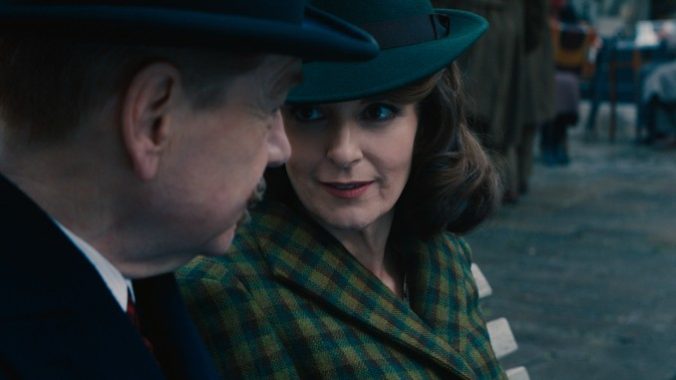Oliver and Company: How Ariadne Oliver Makes A Haunting in Venice Work

I have seen Tina Fey roll her milky white eyeballs at a pompous gasbag of a man more times than I can count. Her expressions of annoyance come from the place of a writer whose work has been interrupted or whose time has been wasted by, more often than not, male ego. There were times across 30 Rock’s seven seasons where Liz Lemon got in her own way, certainly, but the looming presence over her sanity was always some guy in a suit or ketchup-smeared t-shirt. Her “muppet face” would exaggerate her features and irritation would spread across her expression like a crumbling mountain eaten up by the pouring rubble. She just wants to get her work done. Is that so hard to ask? Behind the accentuated sleeplessness in her eyes is the desperate wish to finish that draft. (I relate!)
What was always fun about watching Fey’s performance as the beleaguered TGS with Tracy Jordan head writer was discerning, like on a reality show, which parts of her performance were true, taken from life, and transcendent of the fictional parameters of the faux-SNL writers room. Her huffs and puffs and “Shut it down!”s coalesced into a familiar persona that often needled at the question of to what degree Fey was playing a version of herself. Was her performance truer when it got more absurd, or was the “real” Fey found in the subtler moments, like waking up with food on her face?
At any rate, Tina Fey knows how to play an avatar of a real person—a real writer, no less—contouring the performance with zaniness and surprise for a character who needs exaggeration and excess to work. And her ability to embody the frustrations of a (woman) writer in the face of (male) vanity make her a surprising MVP as crime author Ariadne Oliver in Kenneth Branagh’s Agatha Christie murder-mystery A Haunting in Venice, based (very liberally!) on her 1969 novel Hallowe’en Party.
Ariadne Oliver—who made her first appearance in 1932, in the short story “The Case of the Discontented Soldier,” which ran in Cosmopolitan—was, for Christie, her own avatar and little pawn of self-insertion into her books. In Cards on the Table, the novel where Oliver first meets Hercule Poirot, she is described as “an agreeable woman of middle age, handsome in a rather untidy fashion, with fine eyes, substantial shoulders, and a large quantity of rebellious gray hair with which she was continually experimenting.” Oliver, like Christie, loves apples and working in the tub, and would appear in seven novels with Hercule Poirot and one on her own, The Pale Horse. She is found frequently saying things like, “Now, if a woman were in charge at Scotland Yard!”
Oliver was Christie’s own little girlboss.
But as a proxy for the author, Ariadne Oliver allowed Christie to convey her own frustrations as a writer, the mistakes she made in previous books (hidden like Easter eggs throughout her appearances with Poirot) and, in particular, the dissonance she felt between the fame she had accrued and the character to which it kind of belonged. Oliver, in both the books and Branagh’s film, is the creator of a Finnish detective called Sven Hjerson. Hjerson is nearly more famous than Oliver, and in A Haunting in Venice, the thinness of the self-parody reveals itself as text, with Fey’s Oliver and Branagh’s Poirot admitting that her writing a rice-paper slim variation of the Belgian detective is what launched both of their careers.
-

-

-

-

-

-

-

-

-

-

-

-

-

-

-

-

-

-

-

-

-

-

-

-

-

-

-

-

-

-

-

-

-

-

-

-

-

-

-

-








































